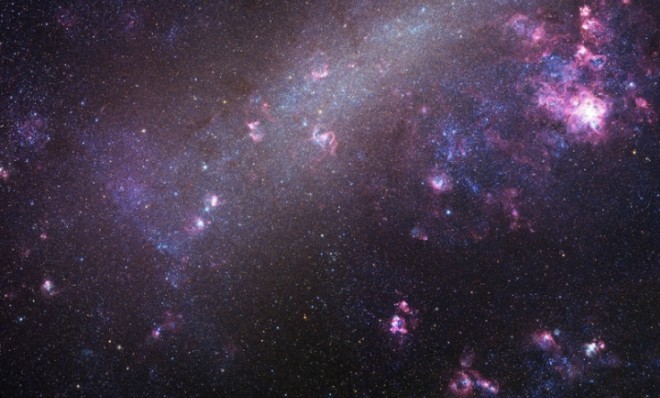How a star-filled space cloud gave astronomers a new cosmic yardstick
Using the Milky Way's neighboring Large Magellanic Cloud, space-watchers now have a new way to measure the universe

The next time you find yourself underneath a clear, starlit sky, pretend you're an astronomer and ask yourself this: How would you accurately measure the distance between two far-away objects separated by hundreds of thousands of light years? (And no, squinting and using your fingers like little pincers doesn't count.) In our own solar system, gauging the distance between two bodies — say Mars and Mercury — isn't too much of a problem. We have tools like satellite probes and radar to help us get accurate readings. It's when we get into the far-out stretches of space, many light years away, that getting an accurate reading of distance gets tough.
To tackle this problem, scientists often use close-enough objects like the relatively nearby Large Magellanic Cloud (LMC) galaxy to estimate the distance between point A and point B — kind of like an interstellar tape measure. The problem, of course, is the universe is always expanding; it's understandably difficult to measure something when a star system keeps running away from you.
But thanks to new research from astronomer G. Pietrzyński, we might be able to get much better, more accurate readings going forward. According to Ars Technica, by identifying a "rare set of binary stars" inside the LMC, astronomers can now measure the LMC's distance from Earth down to 2.2 percent accuracy — a hair's-breadth by the universe's standards. Ars Technica's Matthew Francis explains:
The Week
Escape your echo chamber. Get the facts behind the news, plus analysis from multiple perspectives.

Sign up for The Week's Free Newsletters
From our morning news briefing to a weekly Good News Newsletter, get the best of The Week delivered directly to your inbox.
From our morning news briefing to a weekly Good News Newsletter, get the best of The Week delivered directly to your inbox.
With a truly accurate estimate of the size of Earth's orbit, astronomers can use parallax — the apparent displacement of stars in the sky as Earth orbits the Sun — to find the distances to stars in the Milky Way. Some stars are variable, changing brightness in a predictable way; these provide a means of measuring how far it is to neighboring galaxies.
These and other measurements allow astronomers to calibrate distances to galaxies containing Type Ia supernovae. These explosions are visible billions of light-years away, and outshine everything else in their host galaxies. As acknowledged by the 2011 Nobel Prize in physics, Type Ia supernovae are currently our best way to track the expansion rate of the Universe. [Ars Technica]
According to New Scientist, these bright star-bursts provide unique, easy-to-identify markers, which makes the LMC "a good rung on the cosmic distance ladder." By observing eight different binary systems in the star-filled cloud, the team found that the average distance between the LMC and Earth ranges from 162,900 plus or minus 3,700 light years. "This is the simplest and most accurate technique right now," says Pietrzyński.
Say hello to our new cosmic yardstick.
A free daily email with the biggest news stories of the day – and the best features from TheWeek.com
-
 How climate change is affecting Christmas
How climate change is affecting ChristmasThe Explainer There may be a slim chance of future white Christmases
-
 The MAGA civil war takes center stage at the Turning Point USA conference
The MAGA civil war takes center stage at the Turning Point USA conferenceIN THE SPOTLIGHT ‘Americafest 2025’ was a who’s who of right-wing heavyweights eager to settle scores and lay claim to the future of MAGA
-
 The 8 best drama movies of 2025
The 8 best drama movies of 2025the week recommends Nuclear war, dictatorship and the summer of 2020 highlight the most important and memorable films of 2025